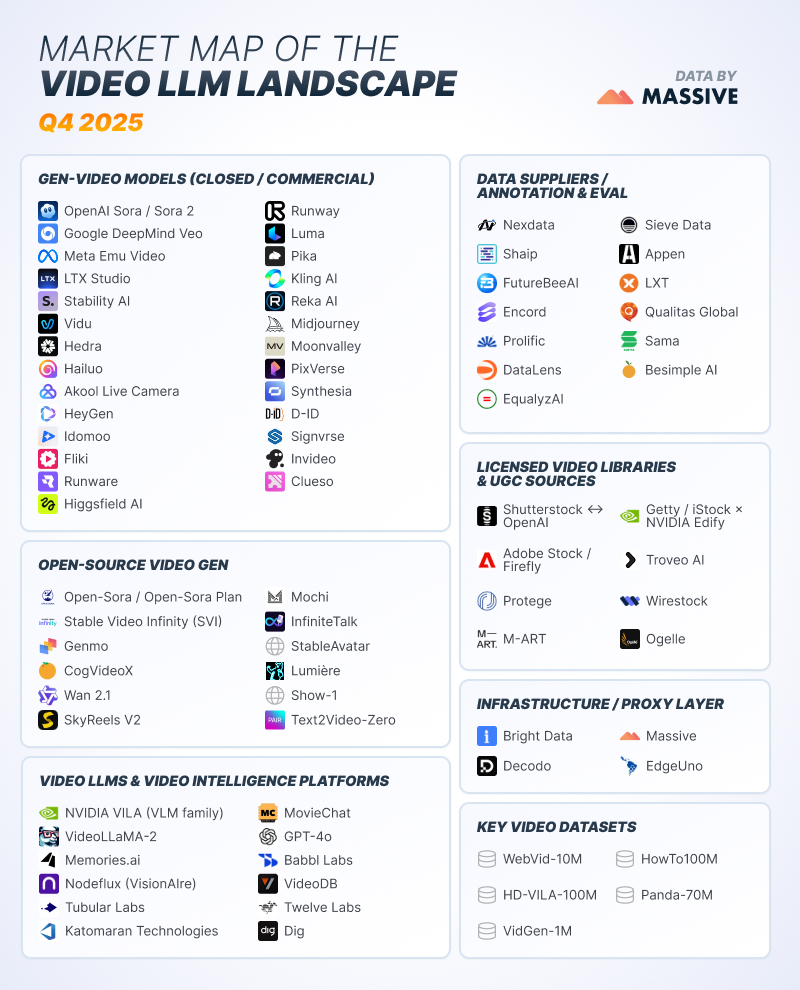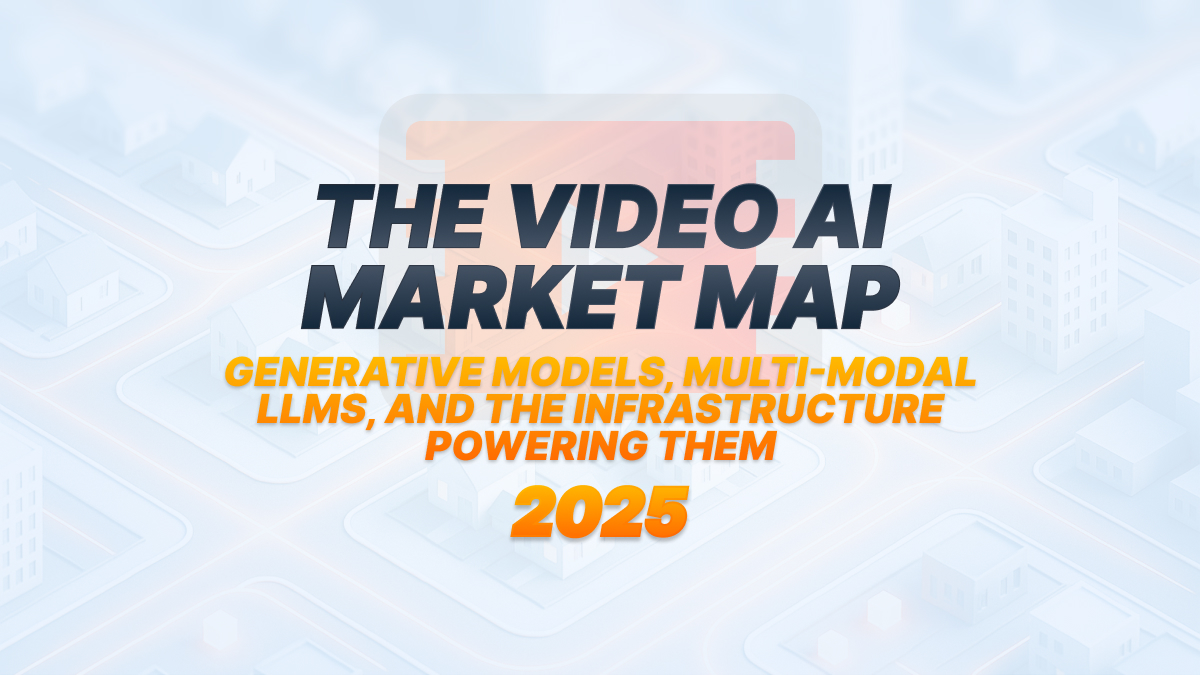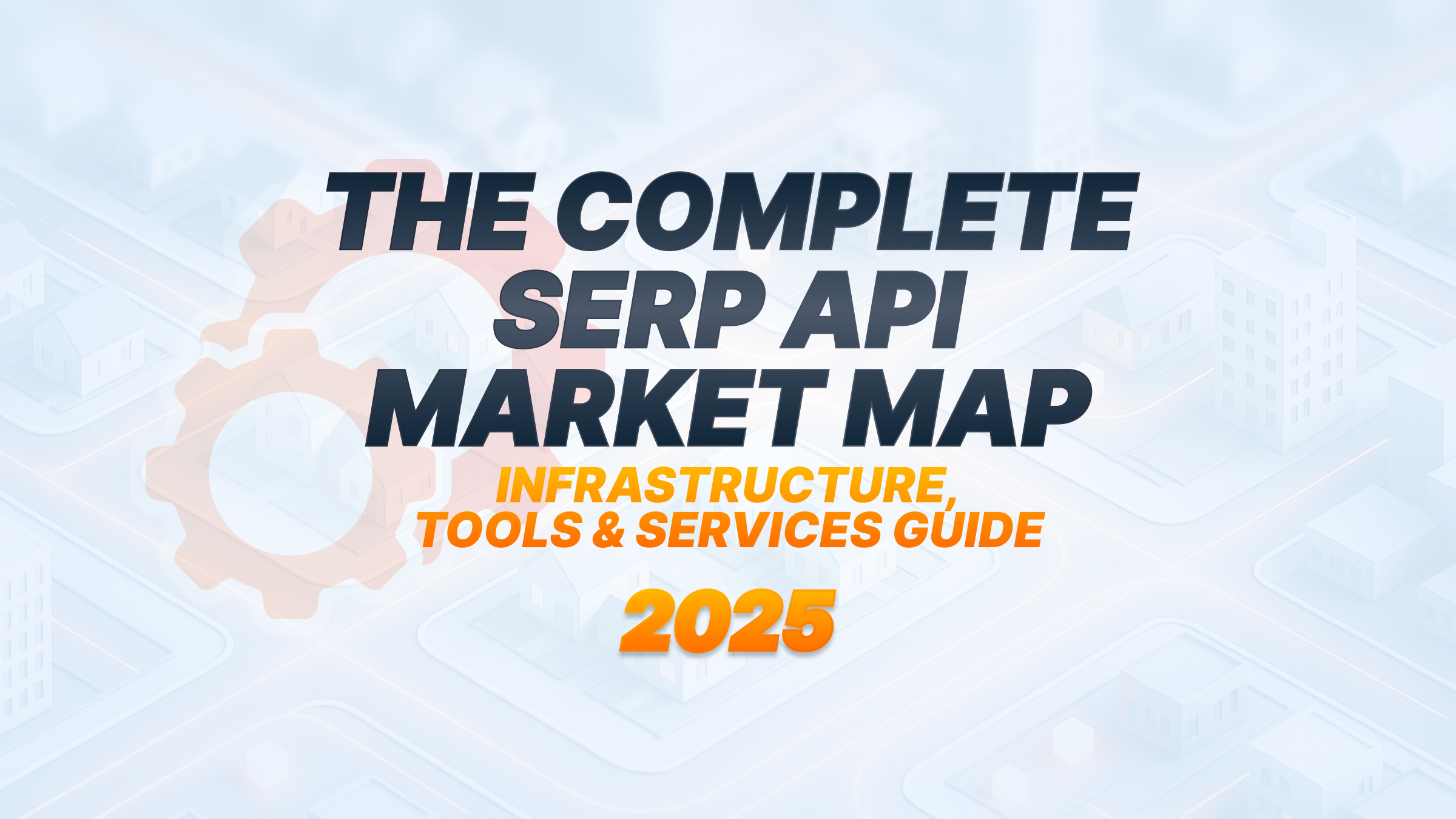The video AI landscape has exploded in 2024-2025, evolving from experimental text-to-video demos into a sprawling ecosystem of commercial platforms, open-source projects, and specialized infrastructure. What started with research labs showcasing proof-of-concepts has matured into an industry where businesses generate marketing videos in minutes, developers build video-native applications, and AI models understand visual content with unprecedented sophistication.
This market map breaks down the key players across seven distinct categories: commercial video generation models, open-source alternatives, video intelligence platforms, data suppliers, licensed content libraries, foundational datasets, and the infrastructure layer that makes large-scale video AI operations possible.

Commercial Video Generation Models: The Race for Quality and Speed
The commercial video generation space is crowded with companies competing on output quality, generation speed, and creative control. These platforms target different segments—from individual creators to enterprise brands—with varying pricing models and capabilities.
OpenAI Sora (including the recently announced Sora 2) represents the high-water mark for photorealistic video generation. Sora can generate minute-long videos with complex camera movements, consistent character appearances, and detailed scene dynamics. Its integration into ChatGPT Plus signals OpenAI's bet that video generation will become as ubiquitous as text generation.
Google DeepMind Veo offers comparable capabilities with particular strength in prompt adherence and physics accuracy. Veo's advantage lies in its integration with Google's broader AI ecosystem, making it a natural choice for businesses already invested in Google Cloud infrastructure.
Runway has positioned itself as the creative professional's tool, offering not just text-to-video generation but a full suite of editing capabilities, including motion brush, inpainting, and frame interpolation. Its Gen-2 and Gen-3 models power countless content creators and production studios.
Luma differentiates through its Dream Machine platform, emphasizing speed and accessibility. Where competitors might take minutes to generate clips, Luma targets near-instant results without sacrificing too much quality—a crucial advantage for iterative creative workflows.
Pika focuses on accessibility and affordability, offering both text-to-video and image-to-video generation with an emphasis on style transfer and creative effects. Pika Labs has built a strong community of independent creators who value its approachable interface and competitive pricing.
Meta's Movie Gen (evolved from Emu Video) leverages Meta's massive social media data advantage. While not yet widely available, Movie Gen promises personalized video generation that understands internet culture, memes, and trending visual styles—a reflection of Meta's unique dataset.
LTX Studio by Lightricks takes a narrative-first approach, allowing users to storyboard entire projects before generation. This appeals to marketers and storytellers who need consistent characters and coherent multi-scene productions.
Kuaishou's Kling AI emerged from China's short-video ecosystem with impressive physics simulation and motion quality. Kling represents the globalization of video AI, bringing competitive pressure from markets with different content preferences and regulatory environments.
Stability AI's Stable Video Diffusion offers more affordable access to video generation through both cloud APIs and local deployment options. As with Stable Diffusion for images, this appeals to developers who need cost control and customization flexibility.
Reka AI focuses on multi-modal understanding across text, images, and video, with generation capabilities that emphasize instruction-following and controllability. Their Reka Core and Flash models compete on inference cost rather than raw quality alone.
Vidu specializes in long-form video generation with particular strength in maintaining consistency across extended sequences—crucial for narrative content and educational videos.
Midjourney's video roadmap remains one of the most anticipated developments in the space. Given Midjourney's dominance in image generation and its community's creative sophistication, its eventual video product will likely emphasize artistic control and aesthetic quality.
Hedra takes a unique approach with its focus on character-driven video, particularly for animated avatars and digital humans. Hedra's technology powers applications in virtual influencers and character-based storytelling.
Moonvalley emphasizes cinematic quality and stylistic control, appealing to filmmakers and visual effects artists who need production-grade outputs rather than social media content.
Hailuo (MiniMax) gained attention for its extended video lengths and competitive quality at aggressive pricing, representing the commoditization pressure facing the entire category.
PixVerse focuses on the creator economy with features specifically designed for social media content: aspect ratio flexibility, trending styles, and rapid iteration.
Avatar and Talking-Head Platforms
A distinct subcategory focuses on human-like avatars and professional video communications:
Synthesia pioneered the corporate video avatar space, allowing businesses to generate training videos, announcements, and presentations without filming. Its multi-language support and professional avatars make it popular for enterprise communications.
HeyGen offers similar capabilities with a stronger emphasis on voice cloning and personal avatar creation. HeyGen appeals to individual creators and smaller businesses who need personalized video communications at scale.
D-ID specializes in animating still photographs into talking videos, with applications ranging from historical education to personalized marketing. Its API-first approach has made it popular with developers.
Akool's Live Camera provides real-time face-swapping and avatar manipulation for streaming and live video applications—bridging pre-generated content and real-time interaction.
Idomoo's Lucas AI targets enterprise personalized video at scale, generating thousands of unique videos for customer communications, data-driven storytelling, and individualized marketing campaigns.
Signvrse appears focused on accessibility, particularly sign-language video generation—an important niche addressing communication barriers for deaf and hard-of-hearing communities.
Video Editing and Automation Platforms
Fliki and Invideo represent the "video-from-text" automation category, turning blog posts, scripts, and presentations into finished videos with minimal manual editing. These platforms target content marketers who need volume over artistic perfection.
Runware operates as a multi-model video API, allowing developers to access multiple video generation models through a single integration—reducing technical complexity and enabling model comparison.
Clueso specializes in product videos and documentation, automatically generating demonstration content from product data and specifications—particularly valuable for e-commerce and technical marketing.
Open-Source Video Generation: The Commons Alternative
The open-source video generation movement mirrors the path of image generation, with community-driven projects democratizing access to technology while pushing transparency and customization.
Open-Sora and Open-Sora Plan represent community efforts to replicate OpenAI's Sora capabilities without the commercial constraints. These projects value reproducibility and researcher access over polish and ease of use.
Mochi focuses on motion-controllable video generation, giving users precise control over movement patterns and camera trajectories—crucial for applications requiring specific kinetic qualities.
Genmo offers both open-source tools and commercial services, straddling the line between community project and startup. Their Mochi-1 model provides strong baseline performance for video generation tasks.
CogVideoX from Tsinghua University's CogLab represents Chinese academic contributions to open video AI, with strong performance on text-video alignment and physics simulation.
Wan 2.1 emphasizes efficiency and local deployment, allowing video generation on consumer hardware rather than requiring cloud infrastructure.
SkyReels V2 focuses on aerial and establishing shots, trained specifically on drone footage and wide landscape videos—a specialized niche within video generation.
Stable Video Infinity (SVI) extends video generation to arbitrary lengths by intelligently connecting shorter clips, addressing one of the major limitations of most video models.
InfiniteTalk and StableAvatar focus on the talking-head problem with open-source alternatives to commercial avatar platforms.
Lumière, Show-1, and Text2Video-Zero represent research-stage projects from academic labs, often introducing novel architectures or training approaches that later influence commercial products.
Video LLMs and Intelligence Platforms: Understanding, Not Just Creating
While generation models create video content, video LLMs and intelligence platforms analyze, understand, and answer questions about video data. This category enables applications from content moderation to security surveillance to media analytics.
VideoLLaMA-2 and NVIDIA VILA represent the video-native evolution of large language models, capable of understanding temporal dynamics, tracking objects across frames, and answering complex questions about video content.
MovieChat specializes in long-form video understanding, enabling conversations about feature-length films or extended footage—far beyond the 30-second clips most models handle.
GPT-4o from OpenAI includes video understanding alongside text and images, representing the "omni-modal" direction of frontier AI models.
Babbl Labs focuses on audio-visual intelligence, understanding speech within video context for transcription, diarization, and content analysis.
Twelve Labs has built a comprehensive video understanding platform offering search, classification, and generation across massive video libraries. Their Marengo model excels at semantic video search—finding moments within footage based on natural language queries.
Nodeflux's VisionAIre targets security and surveillance applications, analyzing video streams in real-time for threat detection, crowd monitoring, and anomaly identification.
Memories.ai focuses on personal video libraries, helping individuals organize, search, and rediscover moments from their own footage using AI-powered semantic understanding.
VideoDB provides a database infrastructure specifically designed for video data, offering vector search, frame-level indexing, and efficient storage for applications built on video understanding.
Data Suppliers, Annotation, and Evaluation: The Training Ground
High-quality video AI requires massive amounts of properly labeled training data. This category provides the human-in-the-loop services that prepare datasets, evaluate model outputs, and ensure quality control.
Nexdata offers comprehensive data collection and annotation services across multiple languages and regions, specializing in culturally diverse training data for global AI applications.
Sieve Data focuses on video-specific annotation workflows, providing frame-by-frame labeling, action recognition tagging, and temporal segmentation for complex video understanding tasks.
Shaip combines annotation services with synthetic data generation, helping AI companies scale their training data beyond what can be manually collected and labeled.
Appen operates one of the largest annotation workforces globally, offering quality control and specialization across domains from autonomous vehicles to content moderation.
FutureBeeAI, LXT, and Encord provide annotation platforms that combine human labeling with AI-assisted tools, accelerating the annotation process while maintaining quality.
Qualitas Global specializes in multilingual annotation and cultural contextualization, ensuring AI models understand regional differences in gestures, expressions, and visual communication.
Prolific and Sama focus on ethical data annotation, ensuring fair compensation and working conditions for annotation workers—an increasingly important consideration as AI companies face scrutiny over labor practices.
DataLens (operating as AI Data Lens and DataLens Africa) emphasizes African perspectives and content, addressing the geographic bias in most video AI training data.
Besimple AI and EqualyzAI focus on bias detection and fairness evaluation, testing AI models for demographic representation and ensuring equitable performance across diverse populations.
Licensed Video Libraries and UGC Sources: Legal Content at Scale
Training video AI legally requires either original content creation or licensing agreements with content owners. This category provides the massive, rights-cleared video libraries that power commercial AI models.
Shutterstock's partnership with OpenAI represents the template for legal video AI training: extensive stock footage libraries licensed specifically for AI training, with revenue sharing to compensate creators whose work trains models.
Getty Images and iStock's collaboration with NVIDIA Edify offers similar rights-cleared content with emphasis on commercial photography and professional footage.
Adobe Stock and Firefly leverage Adobe's massive library of licensed creative assets, providing training data while compensating contributors through Adobe's content authenticity initiative.
Troveo AI aggregates licensed content specifically for AI training, acting as an intermediary between content owners and AI companies.
Protege (formerly Calliope Networks) operates a media and training data platform connecting content rights holders with AI developers, facilitating licensing at scale.
Wirestock enables individual creators to contribute their footage to AI training datasets in exchange for compensation, democratizing participation in the AI training economy.
M-ART specializes in high-resolution 4K and 6K video datasets, providing the visual quality necessary for training state-of-the-art video generation models.
Ogelle focuses on African UGC video content, addressing the geographic and cultural gaps in most video training datasets while providing economic opportunities for African creators.
Key Video Datasets: The Foundation
Certain publicly available datasets have become foundational to video AI research, serving as benchmarks and pre-training sources for both academic and commercial models.
WebVid-10M contains 10 million video-text pairs scraped from the internet, providing the scale necessary for training large video-language models.
HowTo100M features 136 million video clips with automatically extracted narrations from instructional YouTube videos—crucial for models that need to understand procedural and instructional content.
HD-VILA-100M offers high-definition video with dense caption annotations, raising the quality bar for training data beyond the often lower-resolution content in other datasets.
Panda-70M provides 70 million video clips with rich semantic annotations, supporting fine-grained understanding of actions, objects, and relationships.
VidGen-1M focuses specifically on video generation training, curating content with aesthetic quality, creative composition, and production value.
Infrastructure and Proxy Layer: The Invisible Foundation
While the previous categories focus on AI models and data, the infrastructure layer provides the technical foundation that makes large-scale video AI operations possible. Training models on web-scraped data, collecting diverse video content, and operating globally requires sophisticated proxy networks and data infrastructure.
Massive provides ethically sourced residential and ISP proxies across 195+ countries, enabling AI companies to collect geographically diverse training data without triggering rate limits or geographic restrictions. Video AI companies need proxies to access region-specific content, scrape video platforms at scale, and validate their models work correctly across global internet infrastructure. Massive's proxy network supports the data collection pipelines that feed video AI training, ensuring models understand global perspectives rather than being limited to easily accessible content.
Bright Data offers similar proxy infrastructure along with web scraping tools and pre-collected datasets, positioning itself as an end-to-end data collection platform.
Decodo focuses on proxy services specifically optimized for media scraping and video content collection, understanding the unique challenges of large file transfers and streaming data.
EdgeUno provides CDN and edge infrastructure across Latin America, enabling video AI companies to operate efficiently in underserved regions while collecting regionally specific training data.
The Interconnected Ecosystem
These categories don't operate in isolation. Commercial video generation companies license content from stock libraries, train on public datasets, use annotation services to evaluate outputs, and rely on proxy infrastructure to collect global training data. Open-source projects build on public datasets and may eventually influence commercial products. Video intelligence platforms analyze content generated by creation models, creating feedback loops that improve both understanding and generation.
The infrastructure layer enables everything else: without proxies and data collection tools, companies couldn't gather the diverse, global video content necessary to train inclusive AI models. Without annotation services, raw video footage couldn't be transformed into structured training data. Without licensed content libraries, commercial AI companies would face insurmountable legal risks.
Market Trends and Future Direction
Several trends are shaping this market's evolution:
Commoditization pressure is intense. As more models achieve similar output quality, competition shifts to speed, cost, and specialized features. The abundance of options forces differentiation through unique capabilities rather than quality alone.
Multi-modal convergence continues as video generation and understanding merge with text and image capabilities. Future AI models will handle all media types seamlessly rather than requiring specialized tools for each format.
Enterprise adoption is accelerating beyond early-adopter creators. Businesses are integrating video AI into marketing, training, communications, and customer service operations, demanding reliability, security, and compliance that consumer tools may not provide.
Geographic expansion is critical as companies recognize training data bias. African, South American, and Southeast Asian content and perspectives remain underrepresented, creating both ethical concerns and business opportunities.
Infrastructure becomes critical as the volume of video AI operations scales. Companies that initially focused only on models increasingly recognize that data collection, annotation, and global operation require sophisticated infrastructure and partnerships.
The video AI market is no longer a futuristic concept but a functioning ecosystem serving real business needs. From the models that generate content to the infrastructure that makes global operations possible, each category plays a crucial role in an industry that's fundamentally changing how we create, understand, and interact with video content.

I am the co-founder & CEO of Massive. In addition to working on startups, I am a musician, athlete, mentor, event host, and volunteer.








